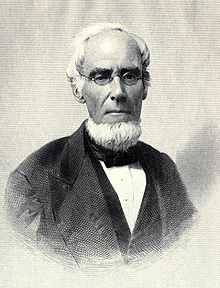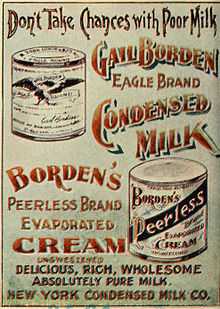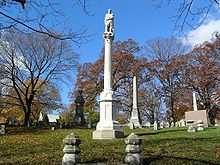Gail Borden
| Gail Borden | |
|---|---|
 Gail Borden (1801-1874) | |
| Born |
November 9, 1801 Norwich, New York |
| Died |
January 11, 1874 (aged 72) Borden, Colorado County, Texas |
| Nationality | United States |
|
Engineering career | |
| Significant projects | condensed milk |

Gail Borden, Jr. (November 9, 1801 – January 11, 1874), was a native New Yorker who settled in Texas in 1829, where he worked as a land surveyor, newspaper publisher, and inventor; he is most known as the developer of condensed milk in 1853. Borden co-plotted the cities of Houston and Galveston in 1836. Having returned to the New York area to market another product, he set up factories for condensed milk in Connecticut, and later in New York and Illinois. Demand was high for his product by the Union Army during the American Civil War. His New York Condensed Milk Company changed its name to Borden after his death.
Early years
Gail Borden III was born in Norwich, New York on 9 November 1801 to Gail Borden, Jr. (1777-1863) a pioneer and landowner, and his wife Philadelphia Wheeler (1780-1828), who died at age 48 from yellow fever in Nashville, Tennessee.[1] The details of Borden's childhood are unclear but he moved twice with his family while growing up, first to Kennedy’s Ferry, Kentucky (renamed as Covington in 1814), and in 1816 to New London, Indiana. Borden received his only formal schooling in Indiana, attending school during 1816 and 1817 to learn the art of surveying.
In 1822 Borden set out with his brother, Thomas. They intended to move to New Orleans but settled in Amite County, Mississippi. Borden stayed in Liberty for seven years. He worked as the county surveyor and as a schoolteacher in Bates and Zion Hill. He was well known around town for running rather than walking to school every morning.
While living in Mississippi, Borden met Penelope Mercer, whom he married in 1828. The couple had six children during their sixteen-year marriage.
Migration to Texas
Borden and his family left Mississippi in 1829 and moved to Texas, following his brother John Borden and parents. Thomas also settled in Texas. As a surveyor, Borden plotted the towns of Houston and Galveston. He collaborated on drawing the first topographical map of Texas in 1835.
Telegraph and Texas Register
In February 1835, Gail and his brother John Borden entered into partnership with Joseph Baker to publish a newspaper. Although none of the three had any previous printing experience,[2] Baker was considered "one of the best informed men in the colony on the Texas-Mexican situation".[3] The men based their newspaper in San Felipe de Austin, which was centrally located among the colonies in eastern Texas.[4] The first issue of the Telegraph and Texas Register appeared on October 10, 1835, days after the Texas Revolution began.[2] As editor, Gail Borden worked to be objective, avoiding blatantly biased or partisan opinions unless a counterpart was also provided.[2][5]
Soon after the newspaper began publishing, John Borden left to join the Texian Army and his brother Thomas took his place as Borden's partner.[6] Historian Eugene C. Barker describes the paper as "an invaluable repository of public documents during this critical period of the state's history".[6]
As the Mexican army moved east into the colonies, the Telegraph was soon the only newspaper in Texas still in operation. Their twenty-first issue was published on March 24.[6] This contained the first list of names of Texans who died at the Battle of the Alamo.[7] On March 27, the Texas Army reached San Felipe, carrying word that the Mexican advance guard was approaching. According to a later editorial in the Telegraph, the publishers were "the last to consent to move".[8] The Bordens dismantled the printing press and brought it with them as they evacuated with the rear guard on March 30.[9][10] The Bordens retreated to Harrisburg. On April 14, as they were in the process of printing a new issue, Mexican soldiers arrived and seized the press. The soldiers threw the type and press into Buffalo Bayou and arrested the Bordens. The Texas Revolution ended days later.[9][11]
Lacking funds to replace his equipment, Borden mortgaged his land to buy a new printing press in Cincinnati.[12] The twenty-third issue of the Telegraph was published in Columbia on August 2, 1836.[12] Although many had expected Columbia to be the new capital, the 1st Texas Congress instead chose the new city of Houston.[11] Borden relocated to Houston, and published the first Houston issue of his paper on May 2, 1837.[12]
The newspaper was in financial difficulty, as the Bordens rarely paid their bills. In March 1837, Thomas Borden sold his interest in the enterprise to Francis W. Moore, Jr., who took over as chief editor. Three months later, Gail Borden transferred his shares to Jacob W. Cruger.[13]
Political career and early Inventions
In Texas, Borden found a new calling of politics. He was a delegate at the Convention of 1833 where he assisted in writing early drafts of a Republic of Texas constitution. He also shared administrative duties with Samuel M. Williams during 1833 and 1834 when Stephen F. Austin was away in Mexico.
President Sam Houston appointed Borden as the Republic of Texas Collector of Customs at Galveston in June 1837. He was popular and performed his job well, raising half of the government income during this period through his collection on importations. Houston's successor to the presidency, Mirabeau B. Lamar, removed Borden from office in December 1838, replacing him in the patronage position with a lifelong friend from Mobile, Alabama, Dr. Willis Roberts, newly arrived in Texas. Roberts' son later was appointed Secretary of State of the Republic. Lamar was said to have known Roberts for 25 years. However, Borden had been so well liked that the newcomer was resented. The Galveston News frequently criticized the new regime about malfeasance.
When a shortage of funds came to light, Roberts offered to put up several personal houses and nine slaves as collateral until the matter could be settled. It was later determined that two resentful desk clerks had been embezzling funds, but this came too late for the doctor, who lasted in the job only until December 1839. Lamar appointed another man of his choice.
After Houston was re-elected to the presidency, he re-appointed Borden to the post, and the publisher served December 1841 to April 1843. He finally resigned after a dispute with Houston.
Borden had since turned his attention to real estate matters. He found a position at the Galveston City Company, where he served for twelve years as a secretary and agent. During that period, he helped sell 2,500 lots of land, for a total of $1,500,000.[14]
During these years, he began to experiment with disease cures and mechanics. His wife Penelope died of yellow fever on September 5, 1844. It caused frequent epidemics and had a high rate of fatalities during the 19th century. Borden began experimenting with finding a cure to the disease via refrigeration. He also developed an unsuccessful prototype for a terraqueous machine. This was a sail-powered wagon designed to travel over land and sea, which he completed in 1848.[15]
Meat biscuits
By roughly 1849, Borden was experimenting with the creation of a dehydrated beef product known as the "meat biscuit", which was loosely based upon a traditional Native American food known as Pemmican. Pioneers seeking gold in California needed a readily transportable food source that could endure harsh conditions and Borden marketed the meat biscuit as a suitable solution. Borden was operating a factory in Galveston, Texas to produce meat biscuits by 1851[16] and the product won him the Great Council Medal at the 1852 London World's Fair. Notably, explorer Elisha Kane even carried a supply of meat bicuits on the Second Grinnell Expedition into the Arctic. However, Borden had been relying heavily upon the United States Army to issue him a lucrative contract to supply meat biscuits for use by American soldiers. When the military declined to buy into the product, Border's meat biscuit proved to be a failure.[17][18]
Condensed milk

During Borden's return voyage from the Exhibition in London, a disease infected both cows aboard the ship. The cows eventually died, along with several children who drank the contaminated milk. Contamination threatened other supplies of milk across the country. In part, the event inspired Borden's interest in preserving milk.[19]
In 1856, after three years of refining his model, Borden received the patent for his process of condensing milk by vacuum. At that time he abandoned the meat biscuit, to focus on his new product. Having lost so much money in his beef biscuit endeavors, Borden was forced to recruit partners in order to begin production and marketing of this new product. He offered Thomas Green 3/8 of his patent rights and gave James Bridge 1/4 interest on his investment; together the three men built a condensery in Wolcottville, Connecticut (within modern-day Torrington), which opened in 1856. Green and Bridge were eager for profits and when the factory was not immediately successful, they withdrew their support; it closed within a year.
But, Borden persuaded them and a third investor, Reuel Williams, to build a new factory, this time in Burrville, Connecticut (also within modern-day Torrington), which opened in 1857. This second factory was hurt by the Panic of 1857 and had trouble turning a profit. The following year Borden’s fortunes began to change when he met Jeremiah Milbank, a financier from New York, on a train. Milbank was impressed by Borden’s enthusiasm for and confidence in condensed milk, and the two became 50/50 partners. Together they founded the New York Condensed Milk Company. As a railroad magnate and banker, Milbank understood large-scale finance, which was critical to development of the business and Borden’s success (Frantz 128). Milbank invested around $100,000 into Borden’s business. When Milbank died in 1884, the market value of his holdings was estimated at around $8,000,000.[14]
With the founding of the New York Condensed Milk Company, sales of Borden’s condensed milk began to improve. The outbreak of the Civil War in 1861 soon after created a large demand for condensed milk from the Union Army, as officers purchased several hundred pounds of milk for their soldiers. In 1861, Borden closed the factory in Burrville, opening the first of what would be many condensed milk factories in upstate New York and Illinois.
Around this same time, Borden married his third wife Emeline Eunice Eno Church.
As the Civil War continued, he expanded his New York Condensed Milk Company quickly to meet the growing demand. Many new factories were built and licenses were granted to individuals to begin producing condensed milk in their own factories using Borden’s Patent. Despite the quick growth of the company, Borden put a high value on sanitation. He developed cleanliness practices that continue to be used in the production of condensed milk to this day. While all of this rapid growth was occurring, Borden continued to experiment with the condensing of meat, tea, coffee, and cocoa, and in 1862 while operating a factory in Amenia, New York, he patented the condensing of juice from fruits, such as apples and grapes.[20] Borden tried to incorporate these other products into the line of the New York Condensed Milk Company but the greatest demand was always for milk. It continued as the company's major product.
Throughout Borden's business success, he maintained an eye toward the scientific community. He published reports filled with testimonials of "impartial" scientists who observed and tested his inventions, including the meat biscuit and condensed milk. Borden coupled ambition for success with an enduring desire to produce quality products.[21]
Later years

Borden died in 1874 in Borden in Colorado County, Texas, which was named after him. His body was shipped by private car to New York City to be buried in Woodlawn Cemetery.
Legacy and honors
- Borden County, Texas, in which he never set foot, was named for him posthumously, as was its county seat, Gail.
- The New York Condensed Milk Company changed its name in 1899, to honor Borden. It continued to be a strong corporation. By the 1940s, the Borden Company employed 28,000 people and had a stock holding partnership of 50,000. It dealt with more varied products ranging from fresh and condensed milk, casein, animal feeds, pharmaceuticals, vitamins, to soy bean creations. A version of the company continues today. Now called Eagle Brand, the company’s website cites its origins in 1856 with the opening of Borden’s first factory.
- In 1892, Samuel and Alfred Church, stepsons of Borden and residents of Elgin, Illinois, purchased and donated the Scofield Mansion at 50 N. Spring Street to house a new library for the residents of Elgin. Samuel and Alfred’s only request was that the library be forever and always known and called the Gail Borden Public Library.
Genealogy
Borden was distantly related to Robert Borden (1854–1937), Canada's Prime Minister during World War I. One of his great-grandchildren was Gail Borden, an American figure skater in the 1936 Winter Olympics. Other notable relative is the famous Lizzie Borden from the Fall River murders. Sir Robert, Lizzie, and Gail Borden (founder) are 4th cousins, all descend from John Borden (b. 1640), the son of Richard from Headcorn, Kent who immigrated to America aboard the ship Elizabeth and Anne in 1635.[22][23]
Patents
U.S. Patent RE2,103; November 14, 1865; Improvements in Condensing Milk
See also
- William Whiting Borden, grandson
References
- ↑ http://worldconnect.rootsweb.ancestry.com/cgi-bin/igm.cgi?op=GET&db=dowfam3&id=I134560
- ↑ 2.0 2.1 2.2 Kökény (2004), p. 284.
- ↑ Franklin (1932), p. 133.
- ↑ Franklin (1932), p. 134.
- ↑ Kökény (2004), p. 285.
- ↑ 6.0 6.1 6.2 Barker (1917), p. 142.
- ↑ Chariton (1990), p. 180.
- ↑ quoted in McMurtrie (1932), p. 184.
- ↑ 9.0 9.1 Lee (1917), p. 216.
- ↑ McMurtrie (1932), p. 184.
- ↑ 11.0 11.1 Kemp (1944), p. 6.
- ↑ 12.0 12.1 12.2 Barker (1917), p. 143.
- ↑ Kökény (2004), p. 289.
- ↑ 14.0 14.1
- ↑ Great citizens: "Gail Borden", Houston History, accessed 11 August 2012
- ↑ Brown, Dee (2012). The American West. Simon and Schuster. ISBN 9781471109331.
- ↑ "Gail Borden’s Meat Biscuits". http://www.texashighways.com''. Texas Department of Transportation. Retrieved 2 January 2015.
- ↑ Cutler, Charles L. (2002). Tracks that Speak: The Legacy of Native American Words in North American Culture. Houghton Mifflin Harcourt. p. 101. ISBN 9780618065103.
- ↑ Gwinn, David Marshall. "FOUR HUNDRED YEARS OF MILK IN AMERICA." New York History 31, no. 4 (October 1950): 448-62. Accessed September 8, 2014. http://www.jstor.org/stable/23149676, 459.
- ↑ United States. Patent Office (1864). Commissioner of Patents Annual Report. United States. Patent Office. p. 466.
- ↑ Borden, Gail, Jr. Gail Borden, Jr. to Ashbel Smith, "Preparation of a New Article of Food, Termed Meat Biscuit," February 1850. 9148017. YA Pamphlet Collection. Library of Congress, Washington D.C. Accessed September 8, 2014. https://archive.org/details/letterofgailbord00bord, Introduction and 1; Borden. The Meat Biscuit: Invented, Patented, and Manufactured. New York, NY: J.H. Brower & Co., 1851. Accessed September 8, 2014. https://ia600402.us.archive.org/0/items/meatbiscuitinven00bord/meatbiscuitinven00bord.pdf, 6; and Bishop, John Leander. A history of American manufactures from 1608 to 1860. 3rd ed. Vol. 2. Philadelphia: Edward Young & Co., 1868. Accessed September 8, 2014. http://books.google.com/books?id=mugJAAAAIAAJ&pg=PA544#v=onepage&q&f=false, 544-546.
- ↑ http://bordenfamily.info/
- ↑ http://www.stephenborden.com/
Further reading
- Barker, Eugene C. (October 1917), "Notes on Early Texas Newspapers, 1819–1836", Southwestern Historical Quarterly 21 (2): 127–144, retrieved December 30, 2009
- Chariton, Wallace O. (1990), Exploring the Alamo Legends, Dallas, TX: Republic of Texas Press, ISBN 978-1-55622-255-9
- Franklin, Ethel Mary (October 1932), "Joseph Baker", Southwestern Historical Quarterly (Texas State Historical Association) 36 (2): 130–143, retrieved December 30, 2009
- Kemp, L.W. (July 1944), "The Capitol (?) at Columbia", Southwestern Historical Quarterly (Texas State Historical Association) 48 (1): 3–9, retrieved December 30, 2009
- Kökény, Andrea (Summer 2004), "The Construction of Anglo-American Identity in the Republic of Texas, as Reflected in the "Telegraph and Texas Register"", Journal of the Southwest 46 (2): 283–308
- Lee, James Melvin (1917), History of American Journalism, Houghton Mifflin Company
- McMurtrie, Douglas C. (January 1932), "Pioneer Printing in Texas", The Southwestern Historical Quarterly (Texas State Historical Association) 35 (3): 173–193, retrieved December 30, 2009
- Joe B. Frantz, Gail Borden: Dairyman to a Nation
- Handbook of Texas Online, s.v. "BORDEN, GAIL, JR," (accessed November 27, 2005).
- Brief biography of Borden
- Longer biographical account of Borden
- Gail Borden Public Library : History of the library (or: "Gail Borden : A condensed history")
- Borden Company, Drinks and Dishes. New York: The Company, 1907.
- Eagle Brand, “History,” Eagle Family Foods-Eagle Brand,
- http://www.eaglebrand.com/ history.asp, accessed 2 February 2009.
- Frantz, Joe B. “Gail Borden as a Businessman,” Bulletin of the Business Historical Society 22, no. 4/6 (Dec 1948) 123-133.
- Garraty, John A. American National Biography. New York: Oxford University Press, 1999.
- Preston, Wheeler, American Biographies. USA: Harper Brothers, 1940.
External links
- Gail Borden at Find a Grave
- Today in Science History - a collection of Borden's patents and nineteenth-century articles and book excerpts on his life and products.
- Gail Borden Public Library, its official website
- Gail Borden Public Library catalog
- Sue Ann Gardner, Gail Borden, University of Nebraska-Lincoln, 1999. (PDF)
- United States Patent Office
|